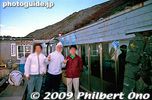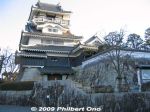 Image search results - "yoshida" Image search results - "yoshida" |

Front of Yoshida Chiaki's home in Niigata (formerly Niitsu) which I visited in Nov. 2007. Yoshida Chiaki composed a song called "Hitsuji-gusa" (Water Lilies) whose melody was used for the song "Biwako Shuko no Uta" (Lake Biwa Rowi
|
|

Former Hatano residence and birth home of Yoshida Togo 旧旗野邸 (吉田東伍生家)
|
|
|

Rear view of birth home of Yoshida Togo who was a famous geographer of Japan who compiled an encylopedia of Japanese place names. His son was Yoshida Chiaki who composed the melody of the song "Biwako Shuko no Uta" (Lake Biwa Rowing Song).
|
|

Front gate of Yoshida Chiaki's home
|
|

A room in the birth home of Yoshida Togo
|
|

Inner garden. I met Yoshida Yuki (吉田ゆき), the niece of Yoshida Chiaki who showed me the house and a few materials. Flowers planted by Chiaki still grow in the garden.
|
|

Garden of the birth home of Yoshida Togo
|
|

Yoshida Chiaki's room on the 2nd floor.
|
|

Entrance to the Yoshida Togo Memorial Museum which exhibits various documents and personal effects of Yoshida Togo. Museum admission 300 yen. Closed Mon.
|
|

Yoshida Chiaki's room on the 2nd floor. This is where he spent his final days while stricken with tuberculosis.
|
|

Inside Yoshida Togo Memorial Museum. The 2nd floor also has a display panel about his son Yoshida Chiaki who composed the song "Hitsuji-gusa" whose melody was used in the song "Biwako Shuko no Uta" (Lake Biwa Rowing Song).
|
|

View from Yoshida Chiaki's room on the 2nd floor. Sometimes they receive local school children for tours of the house.
|
|

Stairs from Yoshida Chiaki's room on the 2nd floor.
|
|

Original copy of the magazine "Ongaku-kai" (The Musical Japan) where Yoshida Chiaki's song "Hitsuji-gusa" was first published and made popular. Issued in Aug. 1915. 音楽界
|
|

Table of Contents of magazine "Ongaku-kai" (The Musical Japan) 音楽界. Many music-related articles.
|
|

On the first page is Yoshida Chiaki's song "Hitsuji-gusa" (Water Lilies) which was acclaimed enough to be published here.
|
|

On the first page is Yoshida Chiaki's song "Hitsuji-gusa" (Water Lilies). Although the melody is different, the lyrics are a direct translation of a childen's song called Water Lilies written by E.R.B. in the UK.
|
|

Small book titled "A Garland of Flower-Poems" published in Japan. This was owned by Yoshida Chiaki and it includes the UK song "Water Lilies."
|
|

Page where "Water Lilies" is printed in the book. It is very likely that Chiaki found the song in this book, and decided to make his Japanese version. His signature is on the back of the book.
|
|

YouTube video of the song Hitsuji-gusa (Water Lilies) by a choir called Koai Gassho no Kai (小合合唱の会) performing at a memorial gathering on the anniversary of Chiaki’s death in Feb. 2013 at Chiaki’s birth home.Video uploaded by Ichii Yasuzo in Niigata.
|
|

Mt. Fuji as seen from the shinkansen bullet train.
|
|
|

Smokestacks mar the view of Fuji.
|
|

Mt. Fuji from the air.
|
|

Yoshida-guchi trail entrance sign.
|
|

Yoshida-guchi trail entrance, we started from the 5th station.
|
|

After climbing for about 40 min., we reached the 6th station here. We're already above the clouds.
|
|

Bags of drink cans.
|
|

Rocky trail looking up on Mt. Fuji.
|
|

Looking down at the trail.
|
|

Hut roofs are weighed down with rocks so it doesn't blow away with the wind.
|
|

Rock and more rock on Mt. Fuji.
|
|

A good part of the trail had us going on all fours.
|
|
|

Mt. Fuji torii
|
|

Our mountain hut on the 8th station, called Toyokan. 東洋館
|
|

Shadow of Mt. Fuji
|
|

We spent the night in the mountain hut with a small dinner.
|
|

Branding my walking stick.
|
|

Our bunk bed.
|
|

Watching the sunrise from outside our hut.
|
|

Reaching the summit.
|
|

At the summit of Mt. Fuji. It was so windy and rainy that we couldn't walk around the rim. Could hardly see anything.
|
|

Going down was tiring too. But better than going up.
|
|

Running through the heart of Gujo-Hachiman, scenic Yoshida River is lined with tourist sights. The castle is on the top of the mountain. The rivers serve as natural moats for the castle.
|
|

Yoshida River in Gujo-Hachiman looking upstream as seen from Miyagase Bridge. In summer, people fish for ayu sweetfish or swim in the river.
|
|

Yoshida River in Gujo-Hachiman looking upstream. There are also cherry blossoms in spring.
|
|

Yoshida River in Gujo-Hachiman looking downstream toward Nagara River.
|
|

Yoshida River's clear and clean water.
|
|

Shinbashi Bridge over Yoshida River. Cross this bridge to the Former Hachiman Town Hall and you will be in Minami-machi or the southern part of town.
|
|

Yoshida River as seen from Shinbashi Bridge.
|
|
|
|

Looking downstream on Yoshida River. Miyagase Bridge can be seen.
|
|

Looking downstream on Yoshida River from Shinbashi Bridge.
|
|
|

Looking downstream on Yoshida River from Shinbashi Bridge.
|
|

Shoin Shrine is dedicated to Yoshida Shoin (1830–1859 吉田松陰), a native of Hagi who was a leading intellectual and educator during the final years of the Tokugawa shogunate.This is the first torii.
|
|

Yoshida is also noted for trying to stowaway on Commodore Perry's USS Powhatan flagship to go to America and study abroad in 1854. He had an eventful but short life, executed at age 29. In Hagi, the Shoin Shrine is dedicated to him.
This short path to the shrine has various monuments.
|
|

Giant ema wooden prayer tablet with a picture of Yoshida Shoin (right) and student Yamagata Aritomo who became the father of Japanese militarism.
|
|

In 2018, Hagi is celebrating the 150th anniversary of the Meiji Restoration.
|
|

Marker for the Shoka-sonjuku school as a historical site.
|
|

About the the Shoka-sonjuku school.
|
|

Yoshida's poem.
|
|

QR code for more info in Japanese.
|
|

About the the Shoka-sonjuku school.
|
|

Shoka-sonjuku school. 松下村塾
|
|

Pictures of the school's famous students.
|
|
|
|

Shoka-sonjuku school. 松下村塾
|
|
|
|

Shoka-sonjuku school lecture room.
|
|
|

Portrait of Yoshida Shoin in Shoka-sonjuku school. He taught at the school for only a year. 松下村塾
|
|

Yoshida Shoin's living quarters.
|
|
|
|
|

Yoshida Shoin was confined here in 1855 after being arrested for trying to stowaway on Perry's ship.
|
|

About Yoshida Shoin's confinement.
|
|

Yoshida Shoin was confined here in 1855.
|
|
|

The school building is the original from Yoshida's days.
|
|
|

Shoin Jinja Shrine torii.
|
|
|
|

Shoin Jinja Shrine dedicated to Yoshida Shoin. 松陰神社
|
|

Inside Shoin Shrine
|
|
|

Adjacent to Shoin Shrine is Shomon Shrine that worships the students of Yoshida Shoin. 松門神社
|
|

Shomon Shrine 松門神社
|
|

About Shomon Shrine. 松門神社
|
|
|
|

Wishes on a pine tree.
|
|

Amulet shop
|
|

Shrine amulets.
|
|

Ema wooden prayer tablet.
|
|
|

Exiting the shrine's torii.
|
|

Monument indicating a visit by the Emperor and Empress and Crown Prince and Princess.
|
|

Filial piety bamboo.
|
|

Mori Shigetaka's tea room in his villa.
|
|

Monument indicating this place as where the Meiji Restoration started.
|
|
|

Happy New Year 2018
|
|

Yoshida Shoin History Museum is also within the shrine grounds. 吉田松蔭歴史館
|
|

Yoshida Shoin's family tree.
|
|

Yoshida Shoin's family when he was a child. (Sugi family)
|
|

Yoshida Shoin with his brother and father.
|
|

Shoin listening to a lecture at the school that hr would later take over.
|
|

Teacher, Mori clan head.
|
|

Yoshida Shoin studying.
|
|

Shoin enters Sakuma Shozan school.
|
|

Commodore Perry's USS Powhatan flagship.
|
|

Commodore Perry's troops.
|
|

Yoshida Shoin riding on a boat to Commodore Perry's USS Powhatan flagship to try and stowaway to America.
|
|

About the Ansei Purge.
|
|

Shoin confined.
|
|

Shoin imprisoned.
|
|

Shoin to be executed. (The museum does not show the decapitation.)
|
|

Historical figures from Choshu (Yamaguchi).
|
|

Leaving Shoin Shrine.
|
|
|
|

Koyama Castle was built by the Takeda Clan in 1568, but destroyed by Tokugawa Ieyasu in 1582 and never rebuilt. Yoshida Town Historic Site.
|
|

Koyama Castle today is a ferroconcrete reconstruction (built in 1987) with fine views of Mt. Fuji and the surrounding area.
|
|

Koyama Castle in Yoshida, Shizuoka. It is modeled after Inuyama castle and does not reflect the design of the original Koyama Castle.
|
|

About Koyama Castle. The reconstructed castle is a local museum.
|
|

Mt. Fuji can be seen from Koyama Castle.
|
|

View from Koyama Castle.
|
|

View from Koyama Castle.
|
|

View from Koyama Castle.
|
|

View from Koyama Castle.
|
|

Saori Yoshida poses with kids holding her three consecutive Olympic gold medals from Athens, Beijing, and London. One of the most winningest wrestlers.
|
|

Three-time wrestling gold medalist Saori Yoshida posing for the picture with kids at Tokyo Marathon 2013.
|
|

She even let one of the kids hold her gold medal.
|
|
|

Three-time wrestling gold medalist Saori Yoshida at Tokyo Marathon event on Feb. 24, 2013.
|
|

Saori Yoshida seemed very nice. She was Japan's key person to help get wrestling back into the Olympics.
|
|
|
|

Three-time wrestling gold medalist Saori Yoshida.
|
|
|
|
|
|